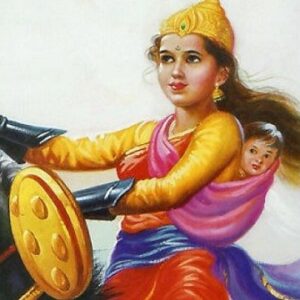Rani Lakshmibai, also known as “Jhansi Ki Rani,” was one of the most important fighters in India’s First War of Independence in 1857. When she was four, her mother died, and that was the first time she had trouble. After that, her father raised her on his own, along with other future revolutionaries, and she grew up to be a strong, independent girl. Her husband, the Maharaja of Jhansi, died when she was only 24 years old, but she didn’t give up and took over his duties. When the British company stolethily took over Jhansi’s land, she and other leaders of the Indian rebellion rose up against them. She shocked the British by fighting with great courage and fighting spirit in battles at Jhansi, Kalpi, and finally Gwalior. She gave hope to many generations of Indian freedom fighters, so she will live on in history. The brave way she chose to die inspired patriots like Shahid Bhagat Singh and revolutionaries like Veer Savarkar and Netaji Subhas Chandra Bose. She became a national hero, and people in India see her as the best example of a brave woman.
Early years and childhood
She was born in Kashi, which is now known as Varanasi, on November 19, 1828. Her father, Moropanth Tambe, was a court adviser, and her mother, Bhagirathi Sapre, was a smart and religious woman. Her parents were from the Brahmin community in Maharashtra.
Her childhood name was Mannikarnika (Manu). She lost her mother when she was four years old, and her father had to take care of the whole family. She grew up with Nana Sahib and Tatya Tope, and all three of them took part in India’s first war for independence.
She also finished her schooling and learned how to do martial arts in a formal way. She also learned how to ride a horse, shoot a target, and fight with a sword.
Accession, and Rule
In 1842, she married Raja Gangadhar Rao Newalkar, Maharaja of Jhansi, and was named ‘Lakshmibai’. Damodar Rao was born to them in 1851, but he died when he was only four months old.
Later, they took Anand Rao in and gave him the name Damodar Rao. Anand Rao was the son of Raja Gangadhar Rao’s cousin. The “Doctrine of Lapse” was used by the British East India Company after Raja died in November 1853.
This was done by Governor-General Lord Dalhousie. Damodar Rao was an adopted son, so he was not allowed to take the throne of Jhansi. Instead, the British company used trickery to add the state of Jhansi to their territory.
In March 1854, she was told to leave the Jhansi fort and move to the Rani Mahal in Jhansi. Each year, she would get 60,000 rupees as a pension. But she was determined to keep her adopted son on the throne of Jhansi.
She didn’t want to leave her empire in Jhansi, so she made its defenses stronger. She put together a volunteer army in which women were also trained to fight. Gulam Gaus Khan, Dost Khan, Khuda Baksh, Lala Bhau Bakshi, Moti Bai, Sunder-Mundar, Kashi Bai, Deewan Raghunath Singh, and Deewan Jawahar Singh were among the warriors who joined her side.
On May 10, 1857, while she was putting together an army, the Sepoy Mutiny of India began in Meerut. This was India’s first war for independence. During this rebellion, Indian soldiers killed many British civilians, including women and children. At the same time, the British troops had to work quickly to put an end to the rebellion, so she was left to run her kingdom on behalf of the company.
In June 1857, a small group of rebels from the 12th Bengal Native Infantry took over the Jhansi fort, where the treasure was kept and killed the European officers and their wives and children. Because of this, she took over running the city and wrote a letter to the British superintendent to explain what had happened.
During her rule, Jhansi was attacked by the forces of British Company allies “Orchha” and “Datia.” Their goal was to split Jhansi between them. She tried to get help from the British, but they didn’t answer. So, she put together a group of soldiers and beat the invaders in August 1857.
From August 1857 to January 1858, when she was in charge, Jhansi was at peace. But the British forces didn’t show up, which made her party stronger and encouraged Indian troops to fight for freedom from British rule. When the company troops showed up and told her to give up the city, she refused and defended her kingdom. So, on March 23, 1858, the battle of Jhansi began.
She and her troops fought bravely for the kingdom of Jhansi, but the British forces beat them and forced her and her son to flee. They went to Kalpi, where Tatya Tope and other rebels joined them.
The British attacked Kalpi on May 22, 1858, and again beat the Indian troops. This time, the leaders, including Lakshmibai, had to flee to Gwalior. The rebel army took over the city of Gwalior without any trouble. She tried to get other leaders to get ready for a British attack on Gwalior, but they wouldn’t listen. When the British attacked the city on June 16, 1858, she was killed in a fierce battle.
Personal History and Legacies
The British army killed her in the battle in Gwalior on June 18, 1858. She fought for her country until her last breath, and when she died, she became a martyr.
Estimated Net worth
Rani is one of the wealthiest queens and is on the list of the most well-known queens. Based on what we found on Wikipedia, Forbes, and Business Insider, Rani Lakshmibai has a net worth of about $1.5 million.


